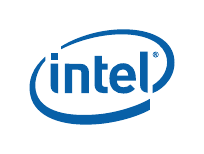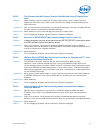
42 Specification Update
BV74. VM Exits Due to “NMI-Window Exiting” May Not Occur Following a VM
Entry to the Shutdown State
Problem: If VM entry is made with the “virtual NMIs” and “NMI-window exiting”, VM-execution
controls set to 1, and if there is no virtual-NMI blocking after VM entry, a VM exit with
exit reason “NMI window” should occur immediately after VM entry unless the VM entry
put the logical processor in the wait-for SIPI state. Due to this erratum, such VM exits
do not occur if the VM entry put the processor in the shutdown state.
Implication: A VMM may fail to deliver a virtual NMI to a virtual machine in the shutdown state.
Workaround: Before performing a VM entry to the shutdown state, software should check whether
the “virtual NMIs” and “NMI-window exiting” VM-execution controls are both 1. If they
are, software should clear “NMI-window exiting” and inject an NMI as part of VM entry.
Status: For the steppings affected, see the Summary Tables of Changes.
BV75. Execution of INVVPID Outside 64-Bit Mode Cannot Invalidate
Translations For 64-Bit Linear Addresses
Problem: Executions of the INVVPID instruction outside 64-bit mode with the INVVPID type
“individual-address invalidation” ignore bits 63:32 of the linear address in the INVVPID
descriptor and invalidate translations for bits 31:0 of the linear address.
Implication: The INVVPID instruction may fail to invalidate translations for linear addresses that set
bits in the range 63:32. Because this erratum applies only to executions outside 64-bit
mode, it applies only to attempts by a 32-bit virtual-machine monitor (VMM) to
invalidate translations for a 64-bit guest. Intel has not observed this erratum with any
commercially available software.
Workaround: None identified.
Status: For the steppings affected, see the Summary Tables of Changes.
BV76. PCIe* Controller May Not Properly Indicate Link Electrical Idle
Condition
Problem: The processor supports a x16 PCIe* port, which can be bifurcated into three
independent links, enumerated as Bus 0, Device 1, Function 0-2. Due to this erratum, if
the port is bifurcated and Function 1 or 2 is disabled, the PCIe controller may not
properly indicate Link electrical idle condition to the Power Control Unit.
Implication: An incorrect Link electrical idle indication may prevent the processor from entering the
lowest power mode, which may cause higher power consumption on VccIO and VccSA.
Intel has not observed any functional failure or performance impact due to this
erratum.
Workaround: If Bus 0, Device 1, Function 1 or 2 is disabled, do not configure the x16 port to allocate
lanes to those functions.
Status: For the steppings affected, see the Summary Tables of Changes.


















